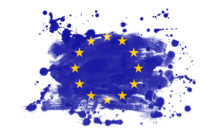

This is part of a series on the Novel Coronavirus (COVID-19) pandemic.
An overview of the impact
The new coronavirus has drastically reshuffled both economies and societies in the past months. The International Monetary Fund (IMF) has described the situation as being a “crisis like no other” with “an uncertain recovery” and a “catastrophic hit” to the global labor market, with more than 430 million jobs losses in the first two quarters.[1] The crisis also brought additional challenges for the non-governmental sector that was already experiencing a shrinking in the civic space in various parts of Europe and around the world.[2]
For what can be analyzed at the moment, the European non-profit sector has taken a considerable hit across the board as the COVID-19 pandemic spread across the continent, bringing both impediments for work continuity, as well as social and financial challenges. An assessment carried out by UK Youth, a British national charity, showed that 64 percent of the youth organizations questioned were likely to lose sources of funding[3] and the percentage is likely to have increased following the lockdown measures applied at the end of March. Despite increased risks posed for the vulnerable communities the NGOs usually work for, the capacity of the non-profit sector to meet those needs is under pressure.
As the pandemic generated relatively similar effects (social interaction restrictions, new forms of running activities, sustained digital presence for citizens and other actors) in most areas of the world, non-governmental organizations (NGOs) in Europe have encountered similar challenges to those in other democratic societies from around the world (the impossibility to run activities as before, the need to adapt budgets, volunteers’ safety etc.). In many parts of Europe, (e.g. Central and Eastern EU Member States, Western Balkan countries, Eastern Partnership countries) the non-profit sector was already fragile due to democratic erosion[4] and was struggling to develop properly. Whereas the pandemic hit both developed and less developed countries, NGOs are disproportionately affected in areas where the sector was already fragile, with lower chances of recovery.
NGOs are facing challenges across the financial spectrum
One of the main issues generated by the pandemic is the increased burden for many NGOs to fight for their organizational recovery and relevance in the non-profit sector, which also leads to a considerable increase in competition for limited available resources (e.g. public grants, including EU funding).[5] This strong competition is further fuelled by shifting trends in the fundraising outlook, as corporate sponsors are reducing their Corporate Social Responsibility (CSR) budgets due to the incoming economic crisis and individual donors are becoming more conservative in their spending habits.[6] Furthermore, governments across Europe might be looking at budget cuts or redistributions in order to sustain the recovery programs and prioritize areas such as health, public safety or saving businesses, which can mean fewer public grants available for NGOs, especially those that are working on youth programs, non-formal education or those that address the needs of various disadvantaged groups.
Some non-governmental organizations fully depend on state funds to operate, others rely almost entirely on entrepreneurial activities, some depend on corporate or foundation funding. Many NGOs rely on physical connections and community access in order to achieve their mission, which are now partially restricted due to public health measures. Those needs are at an all-time high in most European regions and countries, but the capacity of NGOs to serve them is getting lower (for example, 86 percent of UK charities[7] and 64 percent of non-profit responders for a Charity Navigator survey[8] have declared that they are cutting back their services and staff despite growing demand, while 13 percent of Romanian NGOs are planning to close permanently[9]).
The shifting financial outlook risks also bringing more polarization in the non-profit sector. Large organizations have considerable capacity to attract funding and implement programs and will also be more tempted to tap into existing sources of financing, which they were not interested in before, while very small organizations relying solely on volunteers would have very small financial needs and could also flourish on tiny budgets.[10]
Depending on its duration, the pandemic might put at risk mostly medium-sized NGOs, severely increasing the gap between large NGOs and very small ones. Large, well-developed organizations tend to have increased overall capacity (including for attracting funding and implementing projects), better brand recognition, more advocacy influence with public authorities, as well as more developed internal frameworks, which enable the organization to more easily adapt to new governmental regulations. Until recently these large NGOs were not competing directly or too much with small and medium-sized NGOs, especially as they were not looking at the same sources or levels of funding.
However, this might now change. First, several large NGOs (especially from the big international non-profit brands) are under increased pressure in many countries to rely increasingly on local/national funding and less on international funding. Second, the pandemic might push large NGOs to apply for public grants where they compete more with medium-sized organizations. Additionally, large NGOs have both increased capacity and are generally commanding more trust from the government, corporations, and the general public, so in times of crisis they might actually be relied upon more and receive extra funding.
At the other end, small NGOs and even informal groups (some of which appeared during the first phase of the pandemic as community initiatives) tend to focus more on community projects and on volunteers. The majority of these organizations might not have even one paid staff or an office, so their operating costs are very low, and they also tend to be more agile when it comes to implementation. Small NGOs can also very easily rely on microgrants or generally low-value grants or on community donations, which can now also be very easily attracted through digital platforms.
As some of the funding sources have been oriented to respond more to the challenges addressed by the pandemic, many NGOs may be in the position to adapt their mission or to risk the continuity of their work. This leads to a growing and sometimes even fierce competition for grants, sponsorships, and donations, even if in some cases it might be well above the capacity of the NGO to absorb those funds. The “crisis mindset” might encourage many NGO leaders to overpromise even if they risk to underdeliver.
In the non-profit sector, it is quite usual for many organizations, especially small to medium-sized, to survive from one project to another and to build a mix of funding sources that are usually time-limited and project-based. Where the local, national, or European public authorities do not offer institutional grants, there is a strong dependence on either project funding, small businesses, or membership fees. However, the pandemic is putting on hold many projects and adding new layers of complexity due to social distancing rules, which discourage NGOs from organizing physical activities sometimes altogether (especially as they also risk considerable fines in case of a regulation breach or viral outbreak, which many cannot afford).
Additionally, sources of funding are—at least temporarily—contracting, especially from the private sector and individual donors. Corporations which offer NGO grants for specific projects are at risk of reducing their CSR budgets or shifting funding towards medical projects,[11] while individual donors become more conservative in their spending habits and might tend to either donate less or prioritize their donations for medical initiatives. At the same time, those NGOs who were strongly relying on business income from their own social entrepreneurship initiatives might see their income strongly reduced, especially if they do not qualify for governmental relief.
Competition is not, however, limited to financial resources. The capacity of any NGO is given by the hired and voluntary talent it attracts or retains. And right now, retaining employees and volunteers is a key priority, while attracting new talent is becoming a considerable challenge. Although the non-profit sector tends to provide more job satisfaction rates, mainly due to the nature of its community/social impact, that comes usually with the string of job insecurity attached. And amidst a crisis which risks becoming a considerable economic and financial one, talent tends to orient towards jobs which can provide more perceived job security.
Opportunities and trends emerging from the crisis
The pandemic is, however, also bringing a couple of opportunities for the sector. First, as lockdown measures started being enforced in most European countries, NGOs were forced to start an immediate digitalization process and look into transferring at least some of their operations online. There can also be observed the emergence of new digital services for the community (e.g. digital youth work in the youth sector, digital camps etc.). This effect will probably change fundamentally how NGOs operate in a post-pandemic world as the use of digital tools will become part of the day-to-day reality together with online services which will complement physical ones in the community. This will carry on benefits on long-term not only from an NGO development point of view, but also in terms of reaching a broader audience.
Second, we have seen a surge of volunteering and solidarity in several communities, both in organized and informal civil society.[12] As NGOs complemented governmental efforts on fighting the pandemic, this can in theory bring increased influence in policymaking or in their communities.[13] In connection, one of the lingering effects of the pandemic might be that NGO leaders look closer to the resilience of their organization and their capacity to absorb shocks and move forward in times of crisis and uncertainty. Although too early to predict, we might see an emergence of scenario planning, risk management and mitigation plans, consolidated strategies which take into account the need for resilience and reimagination. Additionally, we can expect considerable governance pressure in this direction from the NGO boards.
Thirdly, a trend which has already started since the early phase of the pandemic is related to the increased flexibility of funders, including some offering public grants. We have seen cases of reduced co-financing rates (often to 0 percent down from 10-20 percent), full timeline flexibility for projects, permission to use funds for emerging needs etc. We can positively look out for long-term flexible frameworks from the main funders in Europe, even after the pandemic ends, as the need for strengthening the NGO sector will be greater than ever. In terms of funding, we can also expect new NGO funding models to emerge, with an increased focus on institutional funding, “lump sum”/“unit costs” grants, and a greater attention given to strategic, multi-annual projects (even at smaller level, such as with youth exchanges).
Another trend that can be observed is that of an increased dependence of NGOs on local, national and European public funding. This can become a risk especially in countries where rule of law is under attack by populist governments or authoritarian political leaders, bringing the independence of the beneficiary NGOs into question. It can lead either to a change in the strategy and priorities of the NGO, so it matches the priorities of the government or, in some cases, pressure to only follow the “government line” and avoid any critique.
Furthermore, many advocacy NGOs are now finding new prolific ways or sharing their messages and building coalitions, as well as popular support, especially online. The challenge might be to gather support for issues which do not have the potential to become too political, whereas for the latter we expect this to be much easier in a world which is becoming more polarized. We might also see more informal advocacy initiatives, which are not led by an NGO or a coalition of NGOs initially, emerging online, and mobilizing people for various causes with reduced costs.
Another trend emerging is that of analyzing the real added value brought by the NGOs to their target groups and stakeholders, given the access to digital tools for gathering data.[14] This can lead to consolidation and prioritization in terms of partnerships of all kinds, including supply chains. Of particular importance here is the effect of this on federations across Europe, which sometimes depend on their membership fees. As such, we might see an unprecedented pressure on federations to reform and increase the value they bring to their members, while those failing to reform might disappear from the market.
The current crisis has raised a series of challenges for the European NGOs, but there is to mention that previous issues (e.g. democratic erosion) were already making things harder for the civil society actors. One of the biggest challenges that has been examined is related to the financial spectrum. Not only that—the availability of funds can determine the course of action for an NGO, but it can also trigger vulnerabilities in less served communities. Another challenge that could be further delved into is in regard to the status of democracy and the control and transparency of measures taken by political actors in the previous stages of the pandemic. The commentary has also included a series of opportunities and trends that emerge from the current crisis, out of which we have mentioned the digitalization, the surge of volunteering and solidarity, the increased flexibility of different funders, etc. All of these together aim to emphasize that each crisis should be regarded as an opportunity to improve the status quo and also a context for analyzing what has been done and which should be the next priorities.
Răzvan-Victor Sassu is a social entrepreneur who started working in the non-governmental sector in 2009 by founding the Young Initiative Association. Over the last 10 years he led several youth and NGO capacity-building programs in Romania and at European level, and now he is serving as the President of the Young Initiative Association. He is also currently working at a global level as the Policy & Advocacy Manager of the World YMCA, an organization serving 120 National Movements and advocating for youth empowerment on the global stage.
Eliza Vaș has been working for the European Institute of Romania since 2014, as an expert in European Affairs. She is author and co-author to several publications, her research being focused on European policies, democracy and citizen participation. She has been involved in the Romanian non-governmental sector since 2009 and is vice-president of the Young Initiative Association. Her non-governmental work is focused on projects promoting European values, civic engagement and youth empowerment.
References:
[1] “World Economic Outlook Update”, International Monetary Fund, June 2020, Accessed 1 August 2020. < www.imf.org/en/Publications/WEO/Issues/2020/06/24/WEOUpdateJune2020 >.
[2] Nicolas Bouchet, “A Matter of Precaution—Watching the Shrinking Civic Space in Western Europe”, The German Marshall Fund of the United States, 20 May 2020, Accessed 4 August 2020, < www.gmfus.org/blog/2019/05/20/matter-precaution-watching-shrinking-civic-space-western-europe>.
[3], “The impact of COVID-19 on young people & the youth sector”, UK Youth, 8 April 2020, Accessed 5 August 2020. <www.ukyouth.org/wp-content/uploads/2020/04/UK-Youth-Covid-19-Impact-Report-External-Final-08.04.20.pdf >.
[4] Giada Negri, “How European Civil Society Is Pushing Back Against Democratic Erosion”, Carnegie Europe, 12 March 2020. Accessed 5 August 2020. < https://carnegieeurope.eu/2020/03/12/how-european-civil-society-is-pushing-back-against-democratic-erosion-pub-81254 >.
[5] Michael J. Nathanson, Bradley P. Boyer, “Why coronavirus could devastate charities even more than the Great Recession did”, Marketwatch, 11 April 2020. Accessed 14 July 2020. < www.marketwatch.com/story/why-coronavirus-could-devastate-charities-even-more-than-the-great-recession-did-2020-04-07 >.
[6] Kelly Krawczyk, “Professor discusses how nonprofits have been affected during the pandemic”, Auburn University Newsroom, May 2020. Accessed 14 July 2020. <http://ocm.auburn.edu/experts/2020/05/181612-nonprofits.php >.
[7] “How is COVID-19 affecting NGO finances and operations?”, Bond, 8 April 2020. Accessed 14 July 2020. < https://www.bond.org.uk/news/2020/04/how-is-covid-19-affecting-ngos-finances-and-operations>.
[8] “Impact of the Pandemic & Economic Shutdown on the Nonprofit Sector”, Charity Navigator, 17 April 2020. Accessed 14 July 2020. < https://www.charitynavigator.org/index.cfm?bay=content.view&cpid=7900 >.
[9] “The non-governmental organizations need support measures to adapt and to actively contribute to the social problems generated by COVD-19” (Organizațiile neguvernamentale necesită măsuri de suport pentru a se adapta și contribui activ la rezolvarea problemelor sociale generate de Covid-19), Civil society Development Foundation, 25 March 2020. Accessed 14 July 2020. <www.stiri.ong/assets/files/document_de_pozitie_ong-urile-au-nevoie-de-masuri-de-suport-in-contextul-covid-19_fdsc.pdf >.
[10] Heba Aly, “This global pandemic could transform humanitarian aid forever. Here’s how”, The New Humanitarian, 8 June 2020. Accessed 14 July 2020. < www.thenewhumanitarian.org/analysis/2020/06/08/coronavirus-transform-humanitarianism-aid >.
[11] Gabriela Gutierrez-Huerter, “COVID-19 poses new challenges for corporate social responsibility efforts”, King’s College London, 6 May 2020. Accessed 3 August 2020 < www.kcl.ac.uk/news/covid-19-poses-new-challenges-corporate-social-responsibility-efforts >.
[12] Saskia Brechenmacher, Thomas Carothers, “How is Covid-19 affecting Civil Society worldwide? How is it responding?”, Oxfam Blogs, 23 April 2020. Accessed 18 July 2020. < oxfamblogs.org/fp2p/how-is-covid-affecting-civil-society-worldwide-how-is-it-responding/>.
[13] Federica Bertacchini, Lucía Goberna, “How Will Covid-19 Affect the Role of NGOs”, Dianova, 23 April 2020. Accessed 14 July 2020. < www.dianova.org/opinion/how-will-covid-19-affect-the-role-of-ngos/ >.
[14] “How are NGOs coping with the impacts of COVID-19”, Tola Data, 16 June 2020. Accessed 2 August 2020. < www.toladata.com/blog/how-are-ngos-coping-with-the-impacts-of-covid19/ >.
Photo: White medical mask isolated. Face mask protection against pollution, virus, flu and coronavirus. Health care and surgical concept | Shutterstock
Published on October 6, 2020.




